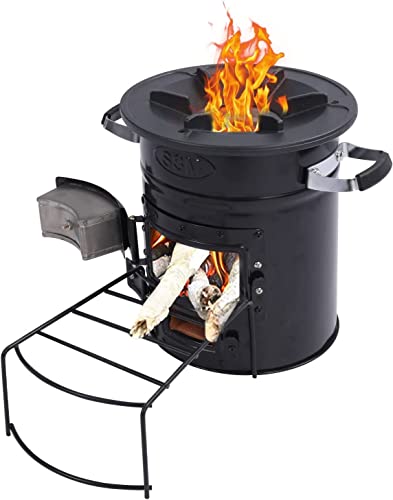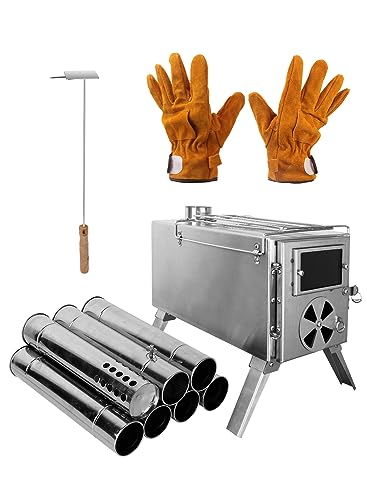7 Simple Changes That'll Make A Big Difference In Your Wood Burning Fi…
페이지 정보

본문
 The Dangers of a Wood Burning Fire
The Dangers of a Wood Burning FireA wood-burning fire can be a relaxing and comfortable experience. However, it could also produce toxic combustion products. It is essential to know how wood burns, and how to use your fireplace properly.
Choose mature logs or kiln dried logs. The logs that are seasoned have less moisture, and they are more likely to burn hotter and longer than unseasoned logs.
Burning Time
The burning of wood to generate heat is a traditional and effective method of heating. However, this kind of fire can release outdoor and best indoor wood burning stove emissions that can be harmful to human health. A well-designed fireplace can help reduce the negative effects of burning wood.
The amount of time a wood fire lasts depends on the degree of heat. The temperature of the fire influences the amount of smoke generated, as well as how much carbon monoxide is released. Carbon monoxide can cause occupants to be unable to escape a burning building if the levels are too high. It is essential to maintain the temperature of the fire at a lower level the fire in order to prevent this.
In the initial stage of a wood-fire, volatile gases like methane and methanol are released from cellulose of the wood. These gases are combustible or non-combustible, depending on the moisture content and the pyrolysis temperature of the sample. The temperature of process can rise to 350 degrees Celsius. At this point the cellulose begins to break down and forms charcoal and tar. This process is called wood pyrolysis.
In addition to the volatile gases, burning wood releases a variety of toxic combustion products, like dioxins and polyaromatic hydrocarbons (PAHs). PAHs are known to cause cancer and other illnesses in animals and humans. They also can contaminate soil and water. Wood must be burnt in a space that is well ventilated to minimize the effects of PAHs.
A wood stove with an extended burn feature can keep visible flames burning for hours while burning the least amount of fuel. This method involves laying wood with lighter kindling and heavier pieces to stop the fire from burning out too quickly. This method can be used for a fire to produce high temperatures, either over night or while you're at work.
The length of the fire is determined by many factors, like the moisture content in the wood. Dry wood will have a shorter burning time than damp wood. The surface's absorptivity affects the duration of its burning. Simms [59] observed that the critical heat flux required to ignite mahogany and oak samples was significantly lower for coated surfaces than without them.
Temperature
The temperature of the fire is very crucial. It affects the speed at which it burns, as well as the heat that it generates. It also influences how dangerous it is to burn yourself. It also affects the amount of smoke that is generated. If there is a lot of smoke, it may cause irritation to the throat and eyes and cause irritation, so it is recommended to avoid breathing it in.
When wood is burned, it generates lots of heat and can reach extremely high temperatures. The temperature of the fire will be affected by the type of wood and the amount of moisture. For instance wet wood has a lower burning temperature than dry wood. This is because wet wood can absorb more water, and therefore less heat. It is essential to use dry wood and you should also ensure that the wood has been seasoned before burning it.
When the wood is at a high burning temperature, a significant amount of heat and ash are released. The amount of ash that is released will be based on the kind of wood that is being burned and how hot it burns. Certain woods like oak and larch release very small corner wood burning stove amounts of ash. Others, such as birch, can create an enormous amount of ash.
As the wood is burned, it will go through the pyrolysis process in three stages. The process begins with the chemical reaction that converts the organic compounds found in the wood into methane and cheap woodburners (please click the following web site) carbon dioxide. The gases produced are then absorbed into the air. These gases will rise when the wood is heated, and create a fire on its surface. a fire that will heat the wood until it ignites.
The temperature of a wood burning stoves on sale-burning fire can be extremely high and it can cause damage to surfaces if it comes in contact with them. Avoid touching the fire with your hands since it could cause serious burns. Wearing gloves and working in an area that is well ventilated will reduce the chance of being burned. Also, it is recommended to wear a face mask when working near an open flame made of wood to avoid inhaling the smoke.
Smoke
Smoke from wood burning fires is released, which is a mixture of gases as well as fine particles (also called particulate matter or PM) that are a source of harmful air pollutants. PM from wood combustion could contain harmful organic compounds such as formaldehyde, benzene, and polycyclic aromatic hydrocarbons, and mineral particles such as calcium, potassium and magnesium. These particles can cause range of health issues, including respiratory and cancer. Smoke from wood can cause people to breathe CO, which is an odorless and colorless gas which can be deadly in small doses.
The smoke emitted by a wood-fire comes mostly from volatile organic compounds (hydrocarbons), which evaporate from the burning material. The smoke is made up of water vapor as well as the by-products from incomplete burning (such as creosote) and some unburned materials called ash.
It is recommended to make use of seasoned wood for your stove or fireplace. Split logs, which have been kept out of the elements and allowed to dry for a period of time until they reach an average moisture content of 20 to 25 percent, will burn more slowly and produce less creosote. A good way to test the moisture content of a piece of wood is to strike it on both sides. A damp log will sound dull while seasoned wood will sound sharp.
The smoke and other by-products are expelled through the chimney. If the ventilation system of the home isn't adequate and the chimney is not properly ventilated, it may be not able to draw enough air and thus create a back draft. This can cause byproducts from the fire to accumulate inside the house. This can result in a buildup of dangerous carbon monoxide, as in flammable creosote and cinders.
Smoke from a wood-burning fireplace can be particularly hazardous to people over the age of 65, those with heart or lung disease, children, and those who are active outdoors. These people are more susceptible to experiencing adverse health effects from smoke from wildfires like COVID-19 symptoms, as well as aggravated asthma and chronic lung and heart conditions.
Safety
If you're using a wood burning fire, there are a few precautions to take to reduce the chance of accidents and fire damage. For instance you should use a fireplace or wood burning stoves uk stove screen and keep anything that is flammable at least 3 feet from it. Additionally you should have smoke detectors and carbon monoxide in your home, which will notify you when any hazardous gases are detected. It is also essential to never leave a flame burning unattended because even a tiny spark can result in an explosion. Also, you should make use of a shovel made of metal and an the ash bucket to clear the ashes from your fireplace or wood stove, and keep it far away from anything that is flammable.
Lighting the Fire
To start a fire, place the dry and cut logs on a bed of ash. Add a layer of twigs and kindling and ash to the pile. It is important to leave enough space between the pieces of wood to allow airflow. This will prevent the fire from dying too quickly. Add a few flames to provide additional help to get your fire going.
Open a window to let the fire breathe the oxygen it needs to burn brightly. This is particularly important for modern homes, which are often tightly insulated and have no natural draft or ventilation.
After the fire has established, you can add more wood pieces. It is important to keep in mind that even the most seasoned hardwoods such as oak and hickory can still release an enormous amount of creosote when they are burned so you should try to avoid burning them as long as possible.
If you can, only burn kiln-dried or seasoned wood to reduce the possibility of creosote build-up in your chimney. However, if you do have to use green or freshly cut firewood, make sure that you do it with great care because it will produce more smoke and create more creosote.

- 이전글시알리스 처방 24.11.05
- 다음글The Best Item Upgrader Tricks To Make A Difference In Your Life 24.11.05
댓글목록
등록된 댓글이 없습니다.
